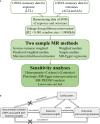Association between genetically predicted leukocyte telomere length and non-scarring alopecia: A two-sample Mendelian randomization study
- PMID: 36798520
- PMCID: PMC9926966
- DOI: 10.3389/fimmu.2022.1072573
Association between genetically predicted leukocyte telomere length and non-scarring alopecia: A two-sample Mendelian randomization study
Abstract
Background: The most commonly acknowledged non-scarring alopecia are androgenetic alopecia (AGA) and alopecia areata (AA). Previous studies have revealed various risk factors associated with alopecia. However, the relationship between leukocyte telomere length (LTL) and non-scarring alopecia remains unclear.
Methods: A two-sample Mendelian randomization (MR) analysis was performed to evaluate the causality between genetically predicted LTL and the risk of non-scarring alopecia. MR analyses were performed using the inverse variance-weighted (IVW) method and complemented with other MR methods.
Results: The summary statistics of the genome-wide association studies (GWAS) for AGA and AA were obtained from the FinnGen biobank, which included 119,185 and 211,428 individuals, respectively. A total of 126 single nucleotide polymorphisms (SNPs) with genome-wide significance were selected as the instrumental variables for LTL. The MR analyses suggested a causal relationship between LTL and AGA, and the risk of AGA increased by 3.19 times as the genetically predicted LTL was shortened by one standard deviation in log transformed form under the IVW method (OR = 4.19, 95% CI = 1.20-14.61, p = 0.024). The other MR methods also demonstrated a similar trend of the effect of LTL on AGA. There was no causal relationship between LTL and AA (p > 0.05). Sensitivity analyses further demonstrated that the current results were less likely to be affected by confounders and bias.
Conclusion: Our results suggested a potential causal relationship between LTL and AGA, and shortened LTL was associated with an increased risk of AGA.
Keywords: Mendelian randomization; alopecia areata; androgenetic alopecia; leukocyte telomere length; non-scarring alopecia.
Copyright © 2023 Li, Yang, Liao, Zheng, Li, Wei, Liu and Yang.
Conflict of interest statement
The authors declare that the research was conducted in the absence of any commercial or financial relationships that could be construed as a potential conflict of interest.
Figures





Similar articles
-
Causal association between telomere length and female reproductive endocrine diseases: a univariable and multivariable Mendelian randomization analysis.J Ovarian Res. 2024 Jul 15;17(1):146. doi: 10.1186/s13048-024-01466-5. J Ovarian Res. 2024. PMID: 39010148 Free PMC article.
-
A causal relationship between leukocyte telomere length and multiple sclerosis: A Mendelian randomization study.Front Immunol. 2022 Jul 15;13:922922. doi: 10.3389/fimmu.2022.922922. eCollection 2022. Front Immunol. 2022. PMID: 35911771 Free PMC article.
-
Leukocyte telomere length and bipolar disorder risk: evidence from Mendelian randomization analysis.PeerJ. 2023 Mar 31;11:e15129. doi: 10.7717/peerj.15129. eCollection 2023. PeerJ. 2023. PMID: 37020849 Free PMC article.
-
Association of telomere length with risk of rheumatoid arthritis: a meta-analysis and Mendelian randomization.Rheumatology (Oxford). 2020 May 1;59(5):940-947. doi: 10.1093/rheumatology/kez524. Rheumatology (Oxford). 2020. PMID: 31697380
-
Identifying Potential Causal Effects of Telomere Length on Health Outcomes: A Phenome-Wide Investigation and Mendelian Randomization Study.J Gerontol A Biol Sci Med Sci. 2024 Jan 1;79(1):glad128. doi: 10.1093/gerona/glad128. J Gerontol A Biol Sci Med Sci. 2024. PMID: 37209418
Cited by
-
Stenotrophomonas maltophilia: An Urgent Threat with Increasing Antibiotic Resistance.Curr Microbiol. 2023 Nov 13;81(1):6. doi: 10.1007/s00284-023-03524-5. Curr Microbiol. 2023. PMID: 37955756 Review.
-
Elucidating causal relationships of diet-derived circulating antioxidants and the risk of non-scarring alopecia: A Mendelian randomization study.Medicine (Baltimore). 2024 Jun 14;103(24):e38426. doi: 10.1097/MD.0000000000038426. Medicine (Baltimore). 2024. PMID: 38875426 Free PMC article.
-
Telomere Length as Both Cause and Consequence in Type 1 Diabetes: Evidence from Bidirectional Mendelian Randomization.Biomedicines. 2025 Mar 22;13(4):774. doi: 10.3390/biomedicines13040774. Biomedicines. 2025. PMID: 40299325 Free PMC article.
-
Loss of Ten1 in mice induces telomere shortening and models human dyskeratosis congenita.Sci Adv. 2025 Apr 11;11(15):eadp8093. doi: 10.1126/sciadv.adp8093. Epub 2025 Apr 11. Sci Adv. 2025. PMID: 40215293 Free PMC article.
-
Exploring the causal relationship between iron status and subarachnoid hemorrhage based on two sample mendelian randomization.Sci Rep. 2025 May 3;15(1):15549. doi: 10.1038/s41598-025-00203-2. Sci Rep. 2025. PMID: 40319034 Free PMC article.
References
Publication types
MeSH terms
Supplementary concepts
LinkOut - more resources
Full Text Sources
Miscellaneous

